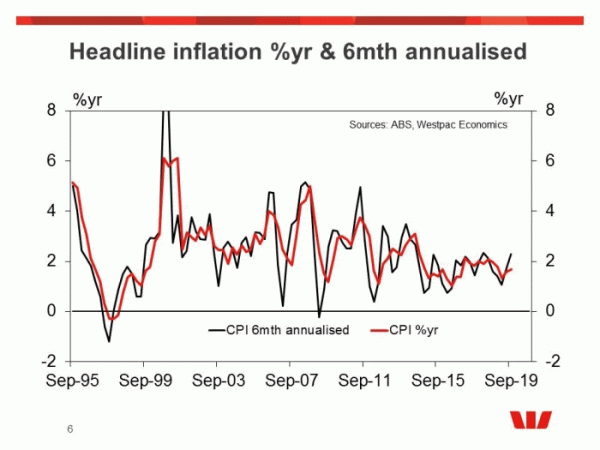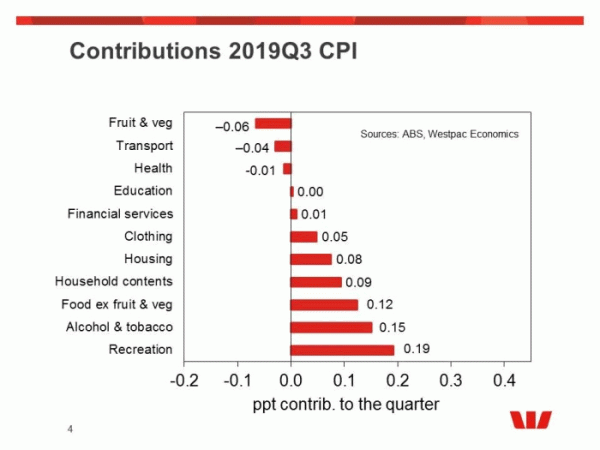September Quarter Consumer Price Index (CPI) Headline CPI 0.5%qtr/1.7%yr Trimmed mean 0.38%q3r/1.6%yr Weighted median 0.33%qtr/1.2%yr
Some modest pass-through from a weaker AUD is not enough to change overall picture.
The September Quarter CPI rose 0.5%, on par with the market median of 0.5% and below Westpac‘s forecast of 0.6%. At two decimal places, the CPI was 0.52% with the annual rate lifting a touch to 1.7%yr from 1.6%yr.
Inflationary momentum, as measured by the six month annualised pace of the seasonally adjusted series, lifted to 2.3%yr from 1.8%yr in September. However, we expect that this momentum will remain patchy and move between 1.6%yr and 2.3%yr looking for the next 12 months.
Following the December quarter report we argued that while we may have found a bottom for the disinflationary pulse, it was too early to call an emergence of a meaningful inflationary pulse. The March and June quarters confirmed a lack of widespread inflationary pressure even if there was some sign that the deprecation in the AUD was starting to be passed through to retail prices. We again saw sign of this pass-through, with a strong than expected 1.5% rise in clothing & footwear, the 1.1% rise in household goods & services and a 6.1% rise in international holiday travel as the result of price increases associated with the northern hemisphere high season.
As expected, housing costs were subdued which is constraining both headline and core inflation. There was the usual seasonal rise in rates & charges (2.5%), gas & other fuels (3.0%) and water & sewerage (2.3%). However, utilities cost remain well contained (+0.7% as default electricity contracts were adjusted – electricity prices fell 0.7%), rent gain just 0.1% and dwelling purchase prices fell 0.2%.
The trimmed mean core inflation measure, which is seasonally adjusted and exclude extreme moves, rose 0.38% holding the annual rate at 1.6%yr. The market was expecting a 0.4% rise in the quarter. In the quarter, the weighted median lifted 0.33%qtr/1.2%yr.
Tradables rose 1.2% in the September quarter. Tradable goods rose 0.3% due to wine (+1.8%), gas & other household fuels (+3.0%), furniture (+2.4%) and garments for women (+1.4%). Tradable services rose 5.8% due to international holiday, travel & accommodation (+6.1).
Non-tradables rose 0.4% in the September quarter. Non-tradable goods rose 0.6% due to tobacco (+3.4%). Non-tradable services rose 0.3% due to property rates & charges (+2.5%).
Despite some AUD pass-through, inflation is below the target band and while the headline rate may drift into the band in 2020, it is likely to be transitory.
There are signs that we are getting some AUD deprecation pass-through to inflation in clothing & footwear (for some selected groups) and in automotive vehicles. But it is harder to find any broader impact or wider inflationary pulse. As such, there is little pressure on the RBA to have to move to a rate cut this year. Westpac’s forecast for the next rate cut is at the February meeting in 2020.
With housing having a significant weighting in the CPI (22%), trends in this group have a meaningful impact on both inflation and core inflation. With such a modest outlook for housing there is little to suggest any risk of a meaningful acceleration in core inflation that would sustainably lift it back into the RBA’s target band.















